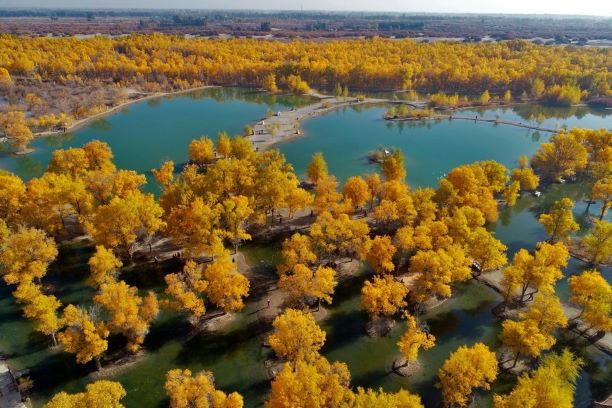“One Tree village” in NW China now has trees everywhere
By Yu Limin, People’s Daily
Aerial photo taken on Oct. 20, 2019 shows the Jinta desert forest park in Jinta county, Northwest China’s Gansu Province. Photo by Cheng Lin/People’s Daily Online
Yikeshu, which literally means “one tree” in Chinese, is an incorporated village in Huamachi township, Yanchi county of Wuzhong, Northwest China’s Ningxia Hui Autonomous Region.
According to a septuagenarian villager, there was indeed only one tree in the village growing on the desert alone when he was little. Unfortunately, it disappeared in the 1980s, leaving the village with nothing but the bare desert.
The past century witnessed the loss of the only tree in the village. However, a woman named Bai Chunlan, together with her husband Mao Xian, has brought drastic changes to the village in terms of vegetation since the 1980s when the couple and other 10 households in the family started making efforts to fight desertification, turning the “One Tree Village” into a home of over 100,000 trees nowadays.
In fact, quite a lot of people had joined the couple in the past years, but ended up quitting due to the harsh conditions.
Bai and her husband chose to stay, and turned the village into a sea of green with unremitting efforts in the past 40 years.
In the 1970s and 1980s, 75 percent of Yanchi county’s residential areas and farmland were located in desert where ecological environment was fragile. Sand storms encroached the arable land of the villages surrounded by sand dunes, making the environment uninhabitable.
“We barely filled our stomachs back then, for no matter what we sowed in the land, nothing grew out of it. Therefore, I was down with the call of the county officials to plant trees no matter how hard it could be, as it could solve our hunger problems,” Bai recalled.
In 1980, when Bai was 27 years old, she and her husband headed to Yikeshu village, carrying their young children and saplings on a wooden cart.
“They all call this place ‘One Tree village.’ Yet when we arrived here, we saw nothing green but infinite yellow sands,” said Bai.
Back then, she had to walked 16 kilometers every day between her home and the planting site, while her husband often spent the nights in desert taking care of the saplings they planted during the day.
“The newly planted samplings were delicate, so it was hard for them to survive. To take care of them, my whole family were digging the sand for water all day. We always brought corn pancakes with us to fill our stomachs,” she told People’s Daily
According to Bai, the heavy sand storm in the “One Tree Village” had once blown away her younger daughter, but she didn’t notice it as she was concentrating on working. The little girl was in a coma when found. Fortunately, nothing bad happened to her. Even till today, Bai still feels regretful about the incident, as she said the mistake would be almost irretrievable.
Nevertheless, most of her memories about Yikeshu village are “sweet.”
In 1984, Bai planted 6,000 square meters of wheat and harvested four sacks of grains the next year. What made her happy was not only the first harvest, but the evidence that the village was able to plant trees and crops.
Bai only attended primary school, but the past 40 years of farming turned her into an expert of agriculture.
Desertification control requires not only hard work, but also scientific and technological guidance.
Bai and her husband were inexperienced at the very beginning. In the early spring of 1984, Bai’s family was awarded with a bundle of superior-variety grape seedlings by the science and technology commission of the Yanchi county. Bai treasured the seedlings very much and planted them in the sand.
All those seedlings died soon, due to the drought, something that Bai later learned from the experts. Yanchi county is located in an arid zone in central China, where the soil lacks viscosity because of the large evaporation.
Since then, Bai has always tried to join technical training.
Learning that an experiment station established by Lanzhou Institute of Desert Research of the Chinese Academy of Sciences is not far from Yikeshu village, Bai invited the station’s experts to teach them how to fix sand with grass grids and help them select saplings that are able to grow in sandy soil, such as salix mongolica, hedysarum leave maxim, and hedysarum scoparium.
In 2005, she set her sights on tourism. By integrating planting, breeding and tourism, she became a bellwether in getting rich. The agritainment farm she runs is now a well-known tourist site of the county.
Bai is 67 years old this year. She’s healthy and is still planting trees, joined by more and more people.
“Planting trees are the source of my happiness. I’ve chosen a job that I love and have a fulfilling career,” she said.













